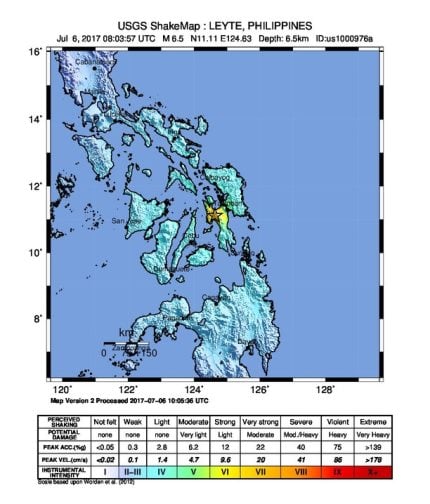M6.5 Masarayao Philippines Earthquake
Status: Closed
| Type of posting | Posting date(EST): | Summary | Downloads |
|---|---|---|---|
| First Posting | 7/7/2017 4:15:00 AM |
|
First Posting | Summary
Posting Date: July 7, 2017, 4:15:00 AM
A shallow earthquake struck just 3 km (2 miles) north-northeast of Masarayao, Philippines, on the island of Leyte at 4:04 p.m. PHT (08:04 UTC) on Thursday, July 6, 2017. With a depth of just 6.5 km (4.0 miles), the strong M6.5 quake killed two, injured more than 100, and caused the collapse of a small hotel in Kananga. No tsunami warning resulted from the event.

ShakeMap for the M6.5 earthquake that struck near Masarayao, Philippines, in late afternoon (local time) on July 6, 2017. (Source: USGS)
The Philippine Mobile Belt (PMB) is a region of rapid deformation and intense volcanism, where multiple tectonic blocks are confined between two opposing subduction zone systems produced by the convergence of the Philippine Sea Plate and the Sundaland (part of Eurasia) Plate. Subduction occurs along the west-verging Philippine Trench-East Luzon Trough and the east-verging Manila-Negros-Cotabato Trench. The entire PMB is a region of intense earthquakes due to these different subduction zones, as well as internal strike-slip faulting occurring mainly along the Philippine Fault Zone and its numerous splays, which traverse the entire Philippine archipelago from south to north.
The July 6, 2017, M6.5 earthquake near Masarayao was located within the central segment of the Philippine Fault Zone. The fault mechanism and depth of the fault indicates that the event was most likely a result of fault movement. The Philippine Fault has been the source of many large historic earthquakes in the Philippines, including the 1990 M7.7 Luzon earthquake, which caused more than 2,400 deaths and billions of dollars of loss.
Damage and Disruption
In addition to the three-story hotel—a 10-year-old building in which one person died and a number of people had to be rescued—the earthquake caused power outages for Leyte and some nearby islands, and forced some geothermal plants to temporarily shut down. Cracks have appeared in buildings and highways, and on the runway at Ormoc Airport, which was forced to close.
Exposure at Risk
The prevalent construction types in the Philippines are unreinforced masonry, reinforced masonry, reinforced concrete, and wood. Reinforced masonry performs much better than unreinforced masonry under small to moderate shaking, yet both are prone to collapse under strong shaking. Many reinforced concrete buildings in the region exhibit relatively high vulnerability to shaking because of lax building code enforcement.
Historically, inadequate foundation and poor construction practices have resulted in building failures from earthquakes in the Philippines. Three moderate earthquakes that occurred since 2001 produced extensive damage to buildings constructed on alluvial deposits without adequate pile support.